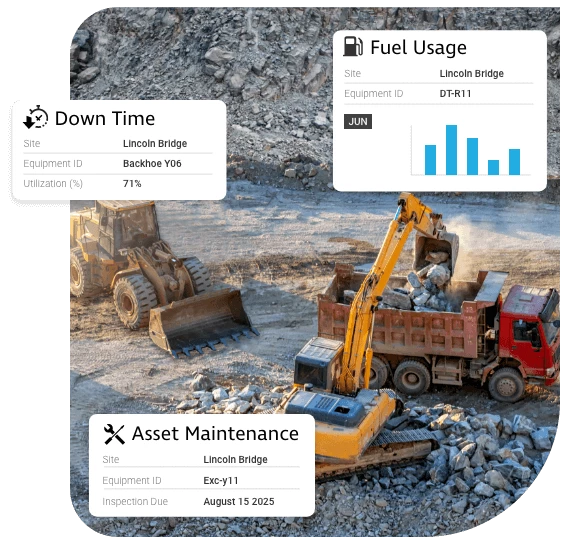What is Asset Tracking?
- On-road trucks & other vehicles
- Heavy construction equipment
- Small powered assets
- Non-powered assets
Why Are Businesses Investing in Asset Tracking?
Asset tracking is essential for many businesses, helping them to use valuable data to protect assets and ensure they're being effectively utilized. Across all industries business are streamlining how they manage assets and are seeing significant results by:
- Increasing asset utilization
- Simplifying maintenance processes
- Lowering rental costs
- Reducing loss or theft
- Maintaining chain-of-custody
- Ensuring customer satisfaction
What asset tracking features should you look for?
Asset tracking solutions have several key features, When asset trackers work with the asset tracking software, it makes managing your operation easier. These are the core features you should be looking for in an asset tracker and the linked software.
- GPS location tracking with custom update rates
- Asset motion alerts
- Geofencing
- Jobsite level reporting
- Maintenance scheduling
- Utilization analytics
- Recovery mode capability
Compare Asset Trackers
The most flexible range of asset trackers to meet your needs

Asset Tracking Software
Asset tracking software brings the data from your vehicles, powered assets and non-powered equipment into one, powerful solution. Our software platform works with a wide range of asset tracking devices, manufacturer installed telematics and mobile applications, to provide the visibility that simplifies complex operations . Through easy to use dashboards, detailed reporting and interactive mapping you can access the critical data you need at any time. Key software feature include:
- Geofencing and site reporting
- Performance dashboards
- Utilization reporting (by site)
- Event reporting and alerts
- Proximity search and reporting
- Maintenance workflows


Software Features
Find the right asset tracking platform for your business
Choosing the right asset tracker
The type of asset you want to track and the update frequency that you require will determine the type of tracking device you need. Here is an overview of the different type assets and the most compatible asset tracker.
- Heavy equipment: Choose a ruggedized, IP67-rated, hard-wired asset tracker that has the capability to capture detailed engine data including engine hours, ideal time and fuel use.
- On road trucks: Choose a device that is hardwired into the vehicle to ensure data reliability for compliance and safety reporting. The device should be able to collect both engine diagnostics and driver behavior data.
- On road light vehicles: Select a self-install device that captures driver behavior data and detailed usage analytics to monitor unauthorized use and driver safety.
- Trailers: Choose a battery or solar powered asset tracker that has extended battery life to support high update frequencies when the trailer is in motion.
- Small assets: Choose a ruggedized battery powered asset tracker that provides location and movement data so you always know where your assets are and when they move.
Asset Tracking Frequently Asked Questions
We have the answers to the most common questions about asset trackers
Maintenance planning digitizes your entire maintenance program, triggering maintenance events via engine diagnostics, engine hours, or manufacturer-set schedules. The system can also track costs and provide insights into where maintenance budgets are being spent. When combined with a full GPS asset tracking platform, this data can be used to educate operators and equipment managers on better upkeep.
Each piece of equipment must have its own GPS tracking device or QR code. The best devices offer customizable update rates, and have extensive connectivity via GPS, CAN bus, and general-purpose input/output (GPIO).
Additionally, solutions that offer hardwired, battery, and solar power options make it easy to integrate diverse types of equipment.
Managing inspections is a key feature of a GPS asset tracking system. By digitizing pre- and post-use inspections, equipment managers can gain better insights into equipment use and upkeep. Spot maintenance issues quickly and act on them before they become large, more expensive problems. Drivers and operators can submit inspection reports digitally, reducing the time and paperwork needed to maintain your fleet.
Our asset tracking software has hundreds of pre-built reporting options and the ability to create custom reports. Prepopulated reports can show location, engine diagnostics, misuse, and more. Reports can also be automated to send to key stakeholders at the desired time.

